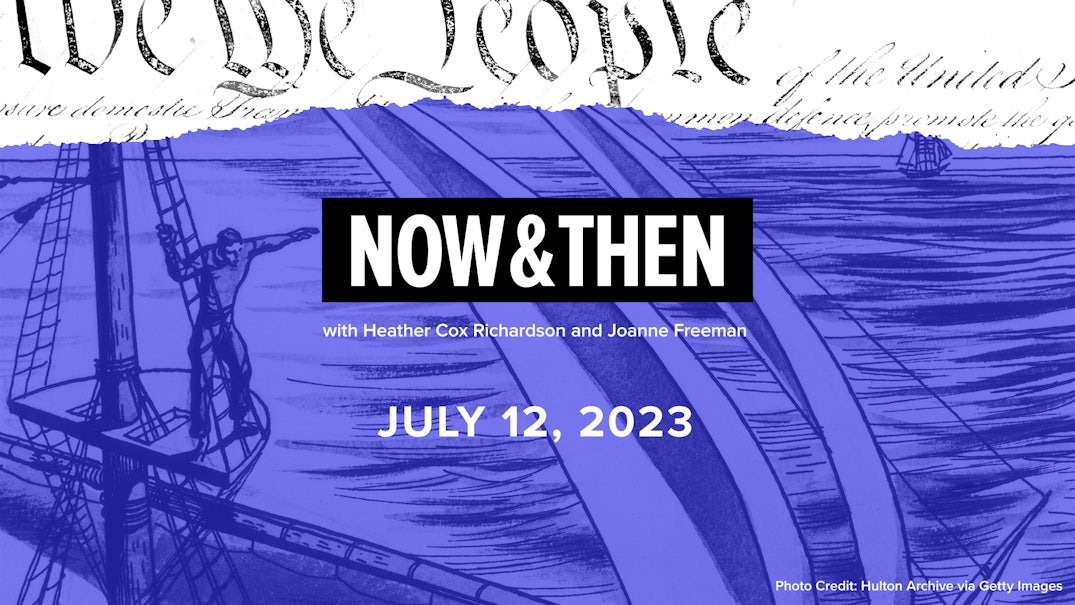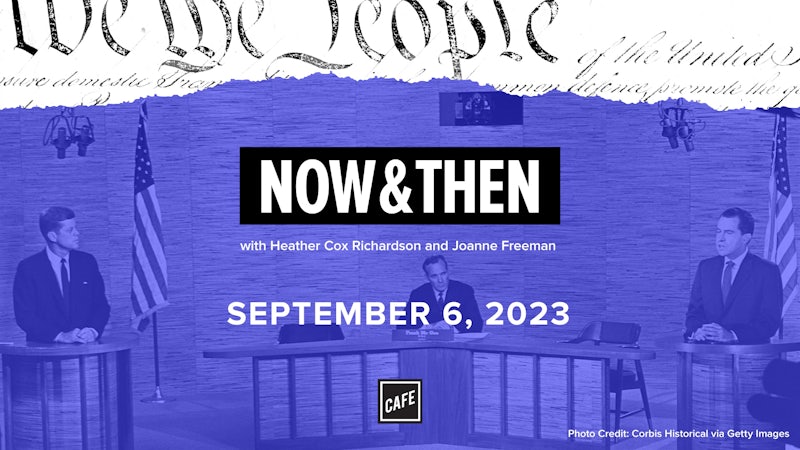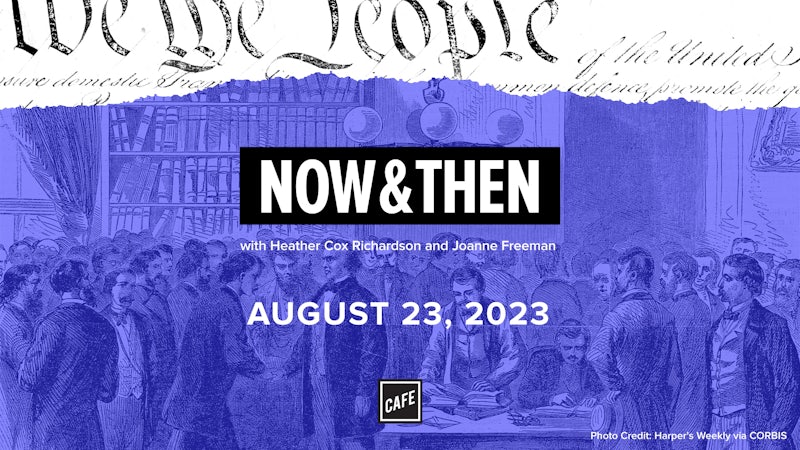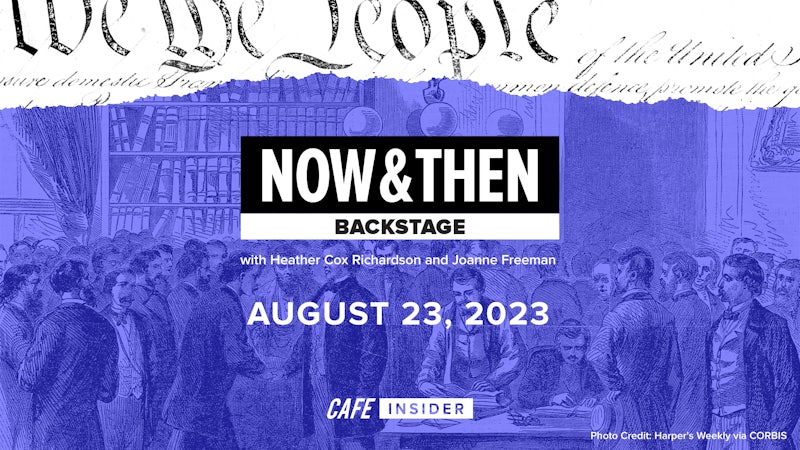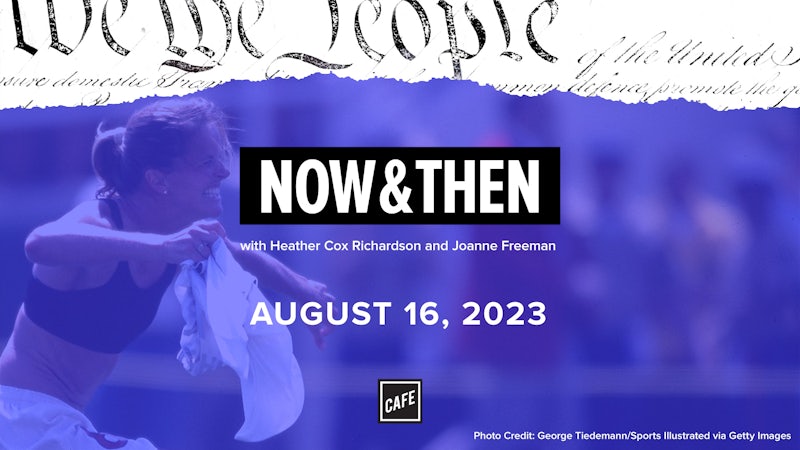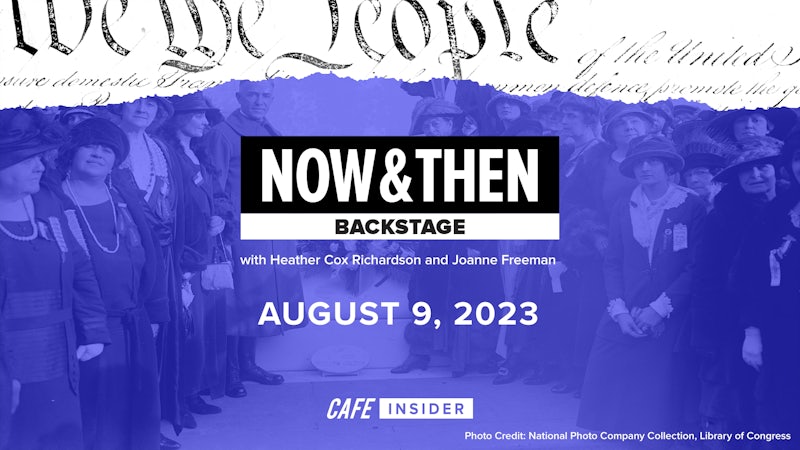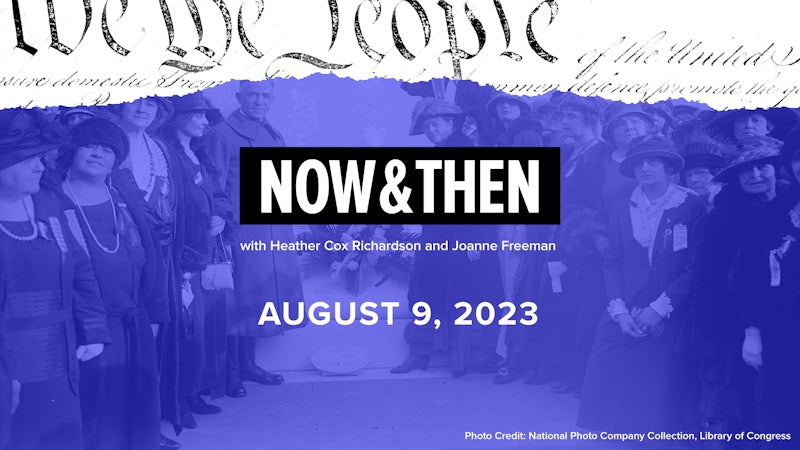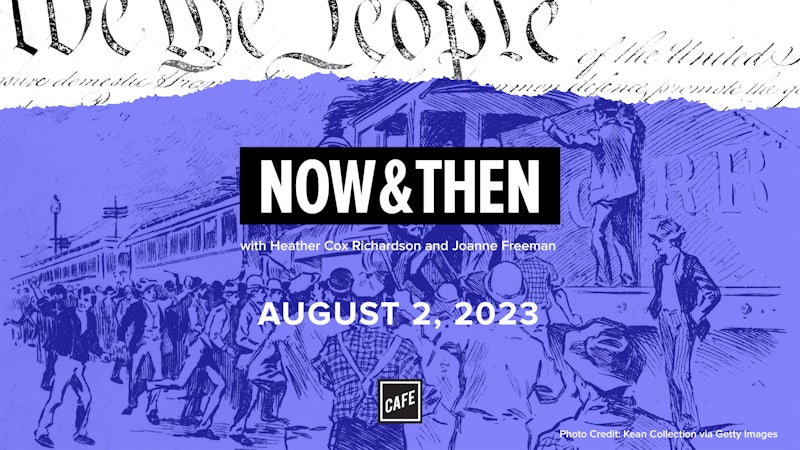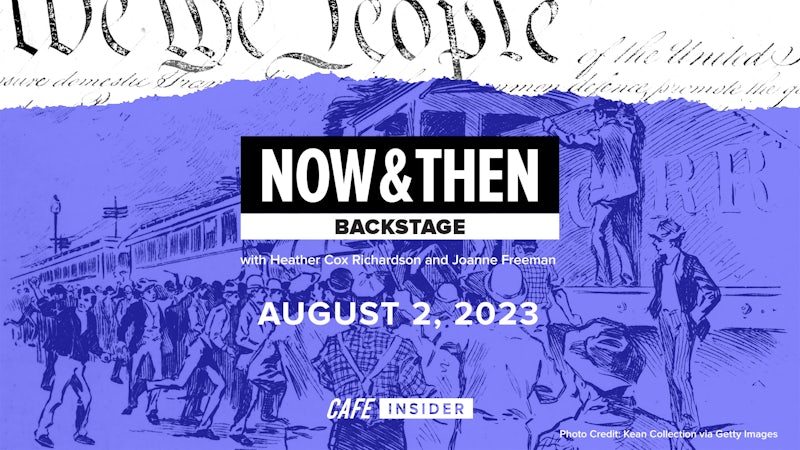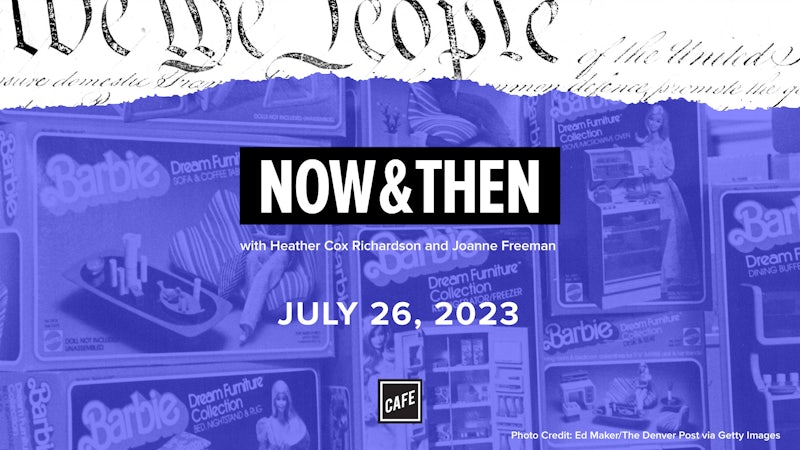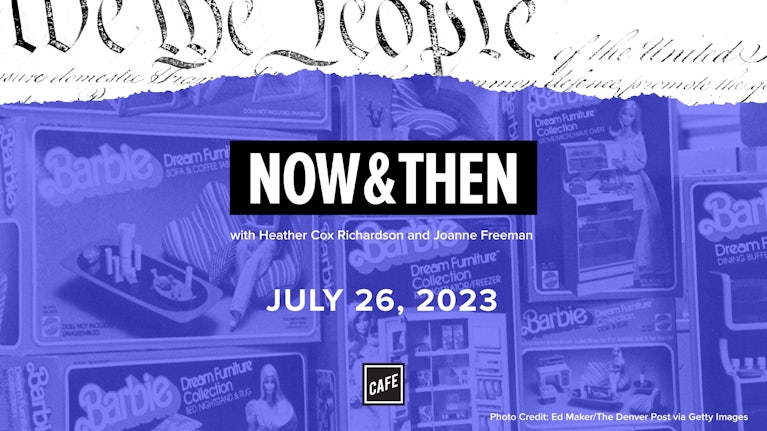Heather Cox Richardson:
From Cafe and the Vox Media Podcast Network. This is Now and Then. I’m Heather Cox Richardson.
Joanne Freeman:
I’m Joanne Freeman. Today we’re going to talk about a topic, the reason for which we’re talking about it will become apparent as soon as I say what it is. We want to talk about disappearances on the high seas. Now obviously this is related to a story that really was all over the press. That’s an understatement recently, and that is the disappearance of the submersible, the Titan, which ultimately was found to have imploded. They found remains of the ship on the floor of the sea.
It was not a mystery any longer. But for those handfuls of days when it was unknown what was happening, the press coverage was over the top. What fascinated us about it, and it’s part of what we want to explore today, is the ways in which the press coverage said a lot more about us than it actually did about the submersible, the Titan. The things that we were interested in or that the press was interested in, that we were reading about and apparently must have been interested in because they kept feeding us more of it.
There were any number of ways in which the coverage suggested a lot about where the United States was now, at least in its mental landscape. For example, given the great wealth inequity that we deal with in so many ways right now, surprise, surprise, there was a story about, right now the word that we use for anyone who’s very wealthy, I guess is billionaires. Billionaires who paid supposedly $250,000 a piece to be on the submersible.
Part of the interest in the story I think was, oh, okay, there’s like a handful of really wealthy people who went down in this submersible and what does that suggest about them? Even in a slightly see me kind of a way, maybe they deserved it should they have spent their money that way. Another really interesting angle was just the idea that the owner of the company poo-pooed regulations because they tamped down on innovation. Here we are at this moment where people are attacking experts. Science is always in the news and the government and its role in regulation. Poof, that becomes a big part of this story as well. That’s what we want to do today is look at specifically two incidents in the past, both involving a disappearance at sea and see what they can tell us about America at the time.
Heather Cox Richardson:
I’m particularly interested in this not only because of what we project onto these disappearances. But also because I think that the stories we tell, at least in the United States having to do with the oceans are peculiarly mythic. That is the oceans are places of enormous mystery. They’re also in between places for a lot of people. They still remain relatively unknown and very, very dangerous. One of the things that’s always interested me, of course, growing up on the water and hearing the stories.
Being married to somebody who’s on the water every day is, how little we actually know about the oceans even still. Compared say to what we know about geology, we know a lot less about the oceans. The oceans are still this extraordinary and extraordinarily dangerous mystery onto which we can project all kinds of human emotions and human fears.
Joanne Freeman:
Related to that is the fact that we don’t control it. We burn down forests. We build things on land. Land is a different category. I think it feels whether or not we actually can control it, it feels controllable. It feels defined. Just as you’re suggesting Heather, the ocean is the ocean. There are still things such as the Titan submersible that happened on the ocean that you don’t predict. You don’t know what happened. The ocean, I think you’re right, as a place that is in comparison with other spheres, relatively unknown, dangerous and seemingly uncontrolled and uncontrollable make it an ideal space for narrative creating. The narratives that we create end up saying a lot about us.
Heather Cox Richardson:
The ocean becomes, and certainly in some of the periods we’re talking about in the United States in the 18th and 19th centuries, becomes a place where individuals feel like they’re able to test their own metal against the elements, against the gods, against the universe. Of course that’s all through our American literature. But a lot of that American literature actually gets its start from some of the stories that we’re going to tell you.
Joanne Freeman:
The first story that we want to focus on has to do with Aaron Burr’s daughter, Theodosia. I know Hamilton fans out there, they know Theodosia because they know the song and they know the name. She was an interesting character in her time. But as we’ll be discussing in a moment, she disappears at sea. One of the interesting things about Theodosia, Alexander Hamilton fans out there will not be thrilled with me. One of the things that sets Burr apart in a positive way is that he was very enlightened or open to ideas about women and intellect at education.
He read Mary Wollstonecraft and he says at one point he can’t find any man willing to discuss it with him. His daughter Theodosia, his only I guess legal child, he educates her. At the time what they said was, “Give her a manly education. Educate her like a man.” Meaning she’s not just educated to sew and dance and have good penmanship. She’s educated in the same sorts of skills that any boy would be educated in at the time. She receives a masculine education.
She’s noted for it so that when you see accounts of her, she’s always pointed at for that. She was remarkably possessed. She spoke multiple languages. She stands out for that reason. She also, of course, is linked with Aaron Burr, who stands out for a lot of reasons. She marries a wealthy planter in the south named Joseph Alston. To set the scene of the sailing of her ship and the missing ship, by the time that this happens, her father had killed Alexander Hamilton in a duel in 1804. Had fled to the South. But recovered from that, wandered out west seemingly to try and create some sort of empire for himself. It’s really not clear what the heck he was doing out there. Then was arrested and put on trial with Theodosia, obviously working on his behalf when he’s being tried. He’s acquitted.
Heather Cox Richardson:
This is the whole thing about him going to the Spanish part of Louisiana and trying to break it off to be its own nation at the base of the Mississippi. Right?
Joanne Freeman:
Seemingly.
Heather Cox Richardson:
That’s the textbook version. I don’t know any of that.
Joanne Freeman:
The textbook version, yes. Is that he took a [inaudible 00:07:18] of men and marched out west and they were armed. They were seemingly trying to be on the spot to take some land. They were seemingly talking to the Spanish government.
Heather Cox Richardson:
But he gets off for that and he runs to Europe.
Joanne Freeman:
Pretty much. Because at this point national politics is out for him.
Heather Cox Richardson:
That whole guns and trying to take over the country thing is not popular. Is that what you’re saying?
Joanne Freeman:
At the time. I don’t know about now, but at the time, yes. Stays for a while in Europe. Then finally comes back to New York. By this point Theodosia has been married, she had a child, the child dies. She’s in poor health. It’s decided that it would be a fine thing for her to head north from South Carolina up to New York to visit with her father, which might be just good for her health. She was 29 in 1812, which is around the time that this is going to begin. What she was suffering from was branded nervous exhaustion. But that could be any number of different things. She was just in poor health, which is part of why she went by water rather than by land to visit her father. It would be supposedly easier traveling that way than going over land.
Heather Cox Richardson:
From South Carolina to New York.
Joanne Freeman:
New York, correct.
Heather Cox Richardson:
That means they’re going to have to go past all the Sea Islands of South Carolina and North Carolina, which have incredibly dangerous shifting sandbars. Just saying. Okay.
Joanne Freeman:
Just throwing that out there as a fact. Yes.
Heather Cox Richardson:
Really, really dangerous. I always thought if I ever get a chance to start writing trashy novels that I would set some there in the Sea Islands because anything could happen in those sea islands.
Joanne Freeman:
That is not a sentence I imagine coming from you. If I ever have a chance to write trashy novels, I will set them in the Sea Islands. I very much like that sentence. She sets out on this ship, the Patriot, along with a friend of the family who’s there to see to her, named Timothy Green.
Heather Cox Richardson:
Wait, in 1812? Isn’t something else somewhat troubling going on?
Joanne Freeman:
Yes, 1812, there’s a famous war. Yes, at the time that she departs, it seems like a relatively safe time to sail. It’s not as though she’s sailing off into a battle. But still, the war of 1812 is getting off the ground at this point. She sets off on the ship and basically never arrives. The ship never arrives. It just goes missing. The trip was supposed to take only five or six days. But the boat ultimately it doesn’t appear. Aaron Burr obviously is desperate to figure out what happened, as is her husband, Joseph Alston.
In mid-January of 1813, about 20 days after the boat had left harbor in South Carolina, Alston writes to Burr tossing blame at Burr, at his father-in-law for encouraging the trip. Alston says, tomorrow will be three weeks since in obedience to your wishes, Theodosia left me. It is three weeks and not yet one line from her. My mind is tortured. The Patriots reputed swiftness and sailing inspired such confidence of a voyage of not more than five or six days. That the three weeks without a letter fill me with unhappiness.
A wretchedness I can neither describe nor conquer. Gracious God is my wife too taken from me? He’s referring to the fact that they lost their child. I do not know why I write, but I feel that I am miserable. Now, the press began to speculate about what happened. I actually, as one does, went wandering through newspapers from the Time this morning because I was just very curious to see what it looked like in the newspapers. Not surprisingly, based on what you mentioned before, Heather, that the war of 1812 is erupting around this point.
For a time, people thought that maybe the British had captured the ship and were holding it. Which was a not horrible outcome because sooner or later then Theodosia might have been able to come home. Then people thought that perhaps it foundered in some way. Again, given sea travel, water travel at the time, highly not normal, but certainly routine, that that happened to ships. Now interestingly, and this is where you start to see the times shape how people are interpreting events like this.
Around 1820, suddenly there are pirate stories that appear regarding this. Pirates took the ship. Pirates made her walk the plank. The reason why this erupts at that point is because apparently in 1820, the US Navy undertook a major anti-pirate campaign. Pirates were getting captured and they were giving deathbed stories of the horrors they committed in their lives. Not surprisingly, that begins to be the story, that pirates captured the ship.
There are different levels of horrible that go along with that. There’s one story that a pirate killed her and buried her in Galveston Bay because she wouldn’t succumb to his desires. There’s another pirate who supposedly felt so bad about having to kill her, that instead he had her walk the plank rather than having to physically kill her. There are all of these pirate stories. Again, it has to do with the fact that pirates are in the news. Pirates are being attacked. Pirates are being captured. These stories don’t stop.
It gets to the point that by 1880, there’s a great headline in the Philadelphia Inquirer that reads, another alleged confession explaining her fate. They’re just all over the newspapers. In the summer of 1869, supposedly there’s a portrait of a young woman discovered at a resort called Nags Head that was in coastal North Carolina. A visiting doctor named William Poole supposedly made a house call while on holiday there. Visited an elderly woman named Mrs. Mann.
There was a beautiful painting in her home. He wanted to know more about the painting, and he asked Mrs. Mann questions about the painting. She said that she had received the portrait from her first husband, a pirate. Once more pirates. The pirate husband claimed that he had boarded an abandoned ship that had been grounded on the shore with a number of other pirate friends, and that he had recovered the portrait-
Heather Cox Richardson:
From a number of pirate friends.
Joanne Freeman:
I know.
Heather Cox Richardson:
These are my pirate friends. These are my non-pirate friends. Sorry.
Joanne Freeman:
Exactly.
Heather Cox Richardson:
They’re pirate friends.
Joanne Freeman:
Yeah. He and the pirate friends boarded the ship, recovered this portrait from a cabin that seemingly was set out for a woman to occupy it. Mrs. Mann’s husband said that other pirates had already stolen a lot of other goods from the ship before driving the ship towards the beach. Now, supposedly members of the Burr family confirmed that the likeness in the portrait looked like Theodosia Burr. That ended up being one hovering clue as to what happened to Theodosia Burr. That pirates boarded the ship. That pirates took everything from it. That the portrait was something that was taken and that explains Theodosia’s fate.
Heather Cox Richardson:
Well, just to make a distinction here, when we think of pirates nowadays, we tend to think about people who are boarding ships at sea. But along the shifting sands of especially North Carolina, but in many places along the coast, the things that we’re calling pirates here were also known as wreckers. Because what they do is they would lure ships to run a ground, usually with lanterns. Then when the ship ran a ground, they would steal everything off it.
Everything off it, like take it apart and take the wood as well. There wouldn’t be plank walking. But if you’re on a ship that runs a ground, especially at night, which is when this tended to happen off the shores of North Carolina. I’m totally making up what might have happened to her, by the way. Not at all a stretch to think that a lot of the people on board would’ve died because they wouldn’t have known how to swim and they’re in the surf in North Carolina or they’re at sea in North Carolina. But the wreckers, that’s how they made their living.
Joanne Freeman:
Then you begin to have people taking advantage of this mystery to write poetry, to write stories. It becomes fictionalized because it is such a good quote, unquote “story.” For example, in 1895, the poet John Williamson Palmer published Theodosia Burr, the Wreckers story, which includes in it the supposed plank walking. Newbie clearly is very excited by this. This is just a little bit from Palmer’s poem. Her steps are doom strokes marking straight to the plank and mounted.
1, 2, 3, 4, we counted until she paused or the flood suspended, poised her live arms extended and the storm stood still and waited for the stroke of the Lord belated. That’s some good 19th century poetry for you. 1957, Robert Frosts has a poem titled Kitty Hawk that has a lot of things in it, including the Wright brothers, but he does also talk about Theodosia Burr. This poem is from 1957, Kitty Hawk. This portion reads, did I recollect how the wreckers wrecked Theodosia Burr off this very shore?
Twas to punish her, but her father more. Burrs always. The fact that she’s linked to Aaron Burr doesn’t help the story making or it helps very much the story making about her fate. Off this very shore was to punish her, but her father more. We don’t know what for, there was no confession. Things they think she wore still sometimes occur in someone’s possession.
Heather Cox Richardson:
What do you think this says about that particular moment? I’m sitting here looking at it and I’m looking at the fact that Theodosia is married to a very wealthy southern man. The daughter of a very prominent northern man at a time when you have real class tensions in America or burgeoning class tensions. Is that part of what’s going on here? Or is it political or is it the fact she’s an educated woman who ends up basically apparently dying at the hands, at least in fantasy, at the hands of an underclass? What’s going on?
Joanne Freeman:
Well, I think there’s a lot of things. Some of it is in a sense the most simple explanation, which is she was a notable, noteworthy woman who already stood out and people noticed her. She was linked to one of the most notorious Americans at the time, Aaron Burr. For those reasons alone, certainly her fate would’ve been noticeable and people would’ve been wondering about it. But I also think that some of it has to do with the very real dangers of traveling by water. A wealthy, well-known woman attached to a well-known notorious semi founder gets lost at sea. As a narrative, that combines a lot of things that are of interest.
Heather Cox Richardson:
I’m looking at it from the outside and saying people could interpret this as punishment for Aaron Burr for his attempt to destroy the country. They could see it as, hey, it doesn’t matter how rich you are, you still could end up walking the plank. It could be there’s just these giant mysteries out there and you don’t know what they are, or maybe all of it wrapped up together. One of the reasons I’m interested in this topic is because of the things we project.
In a romantic sense, not lovey-dovey romantic, but in that 19th century romantic sense, this idea that you have this blank canvas on which you can project all of these different things based on a cartoon narrative, if you will. Somebody sails off into the unknown and you don’t know what happens. That idea of sailing off into the unknown is such a part of world literature, but certainly part of American history. Where people take on the elements, they take on the unknown, and with luck they emerge heroic. But sometimes they don’t emerge.
Joanne Freeman:
Well, also along those lines, this is a wealthy, maybe not famous, but reaching in that direction, person who ends up being out of control. Does not control her fate. Is swallowed by the sea. If you are looking at elite people in this period, in one way or another, and I suppose this has a little tiny echo of what some people were thinking about the Titan. She’s someone famous and wealthy and also at the moment has this tragic loss of her son.
Then she has no control over what happens to her. She sets out, she vanishes. Late 18th and early 19th century newspapers, sometimes they would just have a word before the story in italics with an exclamation point that would say Melancholy! There was a [inaudible 00:20:41] to this of the tragic storytelling component of it. But I think there was a moralistic underpinning. Maybe there was something about this having to do with someone being punished.
In a sense, all of these different narratives we’re talking about here, there’s a desire for a good guy and a bad guy. Is the bad guy, Burr? Is the bad guy, the pirates? Who’s taking what side? What does that say? Americans want to side with what or want who to be the bad guy? But they very much want that to be a story with a lesson of some kind. Some of the narrative spinning has to do with that. What’s the lesson? Well, the lesson is pirates. Pirates are horrible. Well, the lesson is the fates came down on her because of all that her father did.
Heather Cox Richardson:
Okay, I’m going to write my own version, and that’s where she launches a mutiny. Takes over the ship. Sails to some other country and becomes a dictator who makes everybody do exactly what she wants. That’s a good ending.
Many of these points were great transitions to the Mary Celeste, which is another mysterious ship that something happens to and becomes embedded in American mythology. The Mary Celeste is known as a ghost ship. It was found abandoned in 1872. The Mary Celeste leaves New York City headed for Genoa, Italy on November 7, 1872. The captain was a man named Benjamin Spooner Briggs. He was a seaman from Massachusetts. He knew what he was doing.
He brought along his wife and his two-year-old daughter. They had a navigator and five crew members. There were 10 people on board in total. Briggs was a teetotaler. He had a great reputation. The crew was a top-notch crew. The cargo of the ship was alcohol. Its primary cargo was 1700 barrels of alcohol. It sails out of New York, headed for Europe. On December 5, 1872, about a month after it leaves port in New York, a Canadian brig named the Dei Gratia was on a similar route, but was supposed to be eight days behind.
Between the Azores and the coast of Portugal, it spied a ship that was erratic. It was sliding back and forth. The crew boarded it and found the Mary Celeste completely abandoned. But otherwise almost entirely undamaged. The lifeboat was missing and the log had last been updated nine days earlier. It suggested from the coordinates that were in it, that the ship had been about 400 miles away the last time the captain had updated the log. The Dei Gratia’s crew splits up and it sails the Mary Celeste into Gibraltar, and a salvage court gave the money for the recovery of the ship, of the Mary Celeste. Okay. You have this ship that is very well manned coming from New York to Italy on a pretty common route.
Joanne Freeman:
With women and children, on board.
Heather Cox Richardson:
With women and children on board, and it’s empty. There’s no sign of foul play. There’s no sign of damage to the ship. It’s just empty with a valuable cargo on board. One of the theories that comes out immediately is that there is a pirate attack or a mutiny on the part of the crew. Again, the life of people on the water is of great speculation then and now and the different classes aboard the ships and the different peoples aboard the ships.
Because remember, the ships are largely usually going to have seamen from all over the world who end up in ports and take passage working to another port. You don’t necessarily always know who the crew is. But this crew appeared to have been a well-known crew, and Briggs appeared to know exactly what he was doing. One of the things that feeds that speculation is that the rumor circulates immediately that there is blood found on Captain Brigg’s sword and on other parts of the ship. But then it turned out that that was not true. Then people come up with all kinds of different theories about what had happened. One of my favorites is they unintentionally detached the lifeboat from the ship while the passengers were all in it.
Joanne Freeman:
Oops. It’s a little hard to get your mind around how that would happen unless literally, I’m reading about this the other day and I’m thinking a water spout. If a water spout was coming to the ship, I could see people being like, ah, crap, let’s get out of here. But could you really see that? Wouldn’t you figure you’d be safer on the ship? Well, whatever. The people have also suggested that ghosts came aboard ship or other supernatural powers came and cleared the humans off it.
Heather Cox Richardson:
The British and American popular press not surprisingly, very soon picked up on the literary elements. The drama, the suspense, even a romance to what happened to the ship. In early March of 1873 for example, the London Chronicle opened their story on the Mary Celeste by making a little bit of an illusion to some writers. The Chronicle wrote, the Gibraltar Chronicle relates a story which might have given a hint to Edgar Poe or Coleridge.
Now, these kinds of dramatic retellings subside after time in the late 1870s. The Mary Celeste even returned to service as a cargo ship for Boston businessmen. The ship’s new captain, his name was Thomas Fleming, certainly knew of the Mary Celeste’s history. He told the LA Times in 1883 that he had never had a supernatural experience while aboard the vessel. He said that the ship has been a lucky ship ever since and that never a ghost or spook of those who vanished have ever appeared on her since.
This is where, to me, it gets extraordinarily interesting. Because the Mary Celeste controversy comes back in 1883. Now again, to set the stage here, 1883, as I’m sure I’ve alluded to before, is my favorite year in American history because so many things happened. But it is also the year in which the US Supreme Court declares unconstitutional the Civil Rights Act of 1875 through the civil rights cases. Race is on everybody’s mind in a really big way and what the issues of race in the United States are going to mean going forward.
What we know of Mary Celeste’s crew that disappeared, they’re all white. There is no hint that there is any kind of racial story playing out on the Mary Celeste at all. But in 1883, Arthur Conan Doyle, 25 years old, had been a ship surgeon and he later on is going to go on to write the famous Sherlock Holmes stories on which, by the way, I was completely reared.
Joanne Freeman:
A different mystery, but still a mystery, right?
Heather Cox Richardson:
Yes. But you can see all the roots of his style and later mystery writers here in something he publishes in a British periodical called the Cornhill Magazine in 1884. He publishes something called J. Habakuk Jephson’s Statement. This is a fictional retelling of the Mary Celeste mystery from the viewpoint of a supposed passenger. The guy who’s in the title, J. Habakuk Jephson. He is a Civil War veteran. He’s an abolitionist and he’s a doctor who boards the Mary Celeste in hopes that the sea air is going to clear his lungs.
He’s got a lung disease. It is an unbelievable story. Which by the way is available to read online if anybody is interested. It is a complete projection of white racial fears in this period onto the Mary Celeste. What happens is Jephson goes to take passage on the Mary Celeste to help his lungs. It looks great because Briggs knows what he’s doing and the wife and the kid are cute. They’ve got these great talented seamen to get the ship to where it’s supposed to go, and he’s all excited.
There is this other man who takes passage on board the ship, and his name is Septimius Goring. Septimius Goring is this loathsome character from the very beginning. He’s missing fingers. He’s very, very wealthy, obviously. But he makes a big point of the story of talking about how he is biracial or of some kind of mixed race and all of the stereotypes at the time that go along with that. Now as the voyage continues, passengers start dying one by one in incredibly gory ways.
It’s a horror story basically. It turns out that Goring has been secretly changing the navigational instruments on board the ship so that instead of going to where it was supposed to go, it goes to Africa. He kills all the people on board the ship and steals the ship so he can become a king in Africa. What saves the Jephson guy is that because he was an abolitionist, an old, incredibly stereotypical Black enslaved woman during the Civil War.
Because he was a Civil War veteran, gave him a token that offered him protection amongst the superstitious natives of Africa. He comes home and he writes this story. It is this unbelievable window into the worst, most horrific views of race in America in the 1880s. But here’s the kicker. It’s told by a guy from Britain who is clearly trying to establish position as a writer. What does he do to establish that position as a writer? Is he packages this political social set of racist fears from the United States and publishes it in a British magazine that is essentially selling this myth to get him attention.
Joanne Freeman:
That’s fascinating because obviously also in the process saying a lot about the United States to a British audience. Even the fact that the main character, he’s an abolitionist. But he’s an abolitionist who owes his life to a Black woman. The British eliminated slavery far earlier than the United States did. Again, here’s a British author focusing on something that I suppose you could also say the United States lagged in, in how it dealt with this problem, feeding it to a British audience. It would be really fascinating to know what Americans thought about this.
Heather Cox Richardson:
A lot of people thought it was real. It’s written as a first person account as so many 19th century accounts of being on the ocean were. It feels as if it is being told for real. The same way Moby Dick was. Or the same way that two years before the mast was, or all of those stories about what it was like to be on the water were written so people thought it was real. But the other thing that really jumps out when you read it is the recognition in this period of changing technology that you don’t really know where the lines are.
About what is real and what is not. We talked about this when we talked about spiritualism. If you can talk across long distances on the telegraph or the telephone in the 1870s, could you maybe talk to the dead? Within this story, there’s also so much mythology because what this guy Goring wants to do is he wants to go back to Africa and become a king. He arranges for Jephson to escape. Because as long as Jephson is there, the superstitious Africans are going to worship him.
Whereas if he goes back to the gods, they will worship goring. It’s not just the race that he picked up. He also picked up the different pieces of the technological unknown in the late 19th century and also the brushings of culture. We’re starting to get anthropologists and sociologists starting to say, “What does it mean to have a culture? What do people that have been previously thought of as being backward, are they backward?
Would they start worshiping somebody from outside?” Of course, Conan Doyle is going to go on to do that in the rest of his Sherlock Holmes stories. Where there’s always some little thing that if you’re observant enough, you know something that nobody else does. He loves little technological glitches in those stories. But this goes on. First of all, I just found this story eye-popping. But second, then there’s huge new interest in the Mary Celeste.
To the point that most people have at least heard the name even if they don’t necessarily know what it’s about. But then in order to solve this mystery, which had become huge again, the British Strand Magazine asked readers to send in any information they had about the Mary Celeste. We’re going to crowdsource it. A headmaster from a prep school, a fairly Tony Prep school called Peterborough Lodge, sent in a series of papers that his butler, Abel Fosdick had given him on his deathbed.
Joanne Freeman:
In these papers, that seemed to be a diary written at the time of what was going on with the Mary Celeste, Fosdick details his time as supposedly a member of the Mary Celeste’s crew. His entries suggests that one crew member had been attacked by a shark while trying to win a bet about how well he could swim with his clothes on. Supposedly in the chaos that resulted from that episode, a temporary observation deck that Fosdick had supposedly constructed for Captain Brigg’s wife and daughter, collapsed.
Everyone but Fosdick fell into the water. They were all devoured by sharks. Fosdick claimed that he clung to a portion of that collapsed observation deck and washed ashore in Africa. At the time, people were immediately, newspapers and others were asking the question, the logical question, has the greatest of sea mysteries finally been solved? New York Times actually had a headline asking that question. The Times repeated reprinted almost verbatim, Fosdick’s account of the accident.
Now, of course, when people read that account more closely, they discover all kinds of problems with it. The weight of the ship. The makeup of the crew. The weather conditions. It has all kinds of details that don’t match the record of what seemingly happened. After this initial fuss, the Fosdick papers end up being mostly discounted. It’s like that imaginary bloody sword. This explains it all. Oh no, it doesn’t. But it would’ve been a violent tale that somehow or other has a moral attached to it. No, we actually still don’t know what happened.
Heather Cox Richardson:
I do.
Joanne Freeman:
Okay, I’m waiting.
Heather Cox Richardson:
Theodosia Burr started a family of women pirates. Her granddaughter went out and boarded the Mary Celeste. Took all the people off. Brigg’s wife and daughter joined her in their pirate gang, and they tossed all the men overboard.
Joanne Freeman:
Now, what I love about this-
Heather Cox Richardson:
I kind of lost it there at the end, but I was just at the beginning.
Joanne Freeman:
Was good. But what I love about this is I can say the same thing. Which is, and the reason we don’t know that is because it’s such a dire story that no one would want to be true. That people have been hiding the truth. I think that’s excellent, and we can link these two stories together and come up with a semi feminist interpretation. Which says a lot about us, I suppose.
Heather Cox Richardson:
Well, but that’s just it. The idea that the ocean is a vast unknown and it invites people to test it, if you will, in one way or another. Then when there is some kind of a mystery associated, we project onto it, what might have happened there.
Joanne Freeman:
Well, in that sense, the sea becomes a mirror in which we really see ourselves and our time and our interests and our fears. Obviously, that mirror can change a lot over time, which brings us back to the submersible, the Titan. What we saw when we looked at that particular mirror. One of the things we didn’t mention at the beginning of this episode, but that falls right into this category, is the fact that many people thought that the coverage of the Titan said a lot about who we were.
Because what wasn’t being covered was a massive wreck in which what is believed to be the second-deadliest refugee shipwreck on record. As many as 800 migrants sank off the Greek coast. What people began pointing out again and again as they talked about the Titan submersible was, isn’t it interesting that the press is all interested in that, and they’re not focusing on the loss of 800 lives. That’s getting almost no coverage at all. That in the end, part of at least what some people saw when they looked in that mirror, that was the Titan submersible incident, was a press that was focused on good stories and a lack of morality in the modern mind.
Heather Cox Richardson:
In that period in which the submersible was missing, but before we knew what had happened, there were a number of stories lionizing the people on board as explorers. As people finding something new in a world that had been so circumscribed by technology, by the rapid transfer of information, by so many things.
Joanne Freeman:
Attaching them to other kinds of narratives, right?
Heather Cox Richardson:
That’s right.
Joanne Freeman:
If you’re an explorer, then you’re linked to these other kinds of people who are brave and sacrificing themselves to go off and find amazing things. That creates a backstory if that’s what you’re doing.
Heather Cox Richardson:
Contrasting that with the people who said, “Why are we spending gazillions of dollars to find people who chose to go down in this Titan? When in fact, we can look right here on the surface to stories we know the answer to.” The 800 migrants. Maybe that’s part of the story itself, that the fascination with the Titan in the days when it was lost were because we didn’t know the outcome and we could project the outcome.
Joanne Freeman:
We projected the outcome, but we projected it in politicized ways. In ways that were divergent. In that sense again, in a mirror sort of way in which some people wanted the explorer great men tale to be true. Others said, “I don’t care about the explorers and the great men. 800 people died like everything else in the current moment.” There were different narratives with very different lessons, very different morals behind them.












